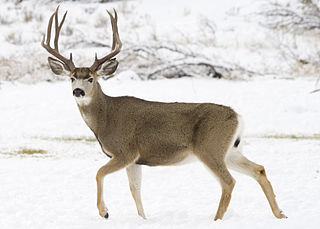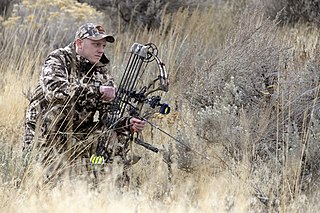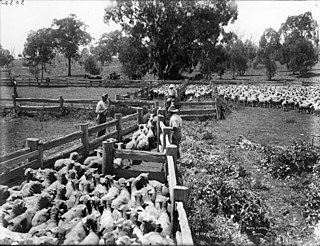Related Research Articles

Antlers are extensions of an animal's skull found in members of the Cervidae (deer) family. Antlers are a single structure composed of bone, cartilage, fibrous tissue, skin, nerves, and blood vessels. They are generally found only on males, with the exception of reindeer/caribou. Antlers are shed and regrown each year and function primarily as objects of sexual attraction and as weapons.

The jackalope is a mythical animal of North American folklore described as a jackrabbit with antelope horns. The word jackalope is a portmanteau of jackrabbit and antelope. Many jackalope taxidermy mounts, including the original, are made with deer antlers.
Dewey is the first cloned deer and was born on May 23, 2003. Specifically, he is a White-tailed Deer, or Odocoileus virginianus, and was cloned from a dead buck by the Texas A&M University College of Veterinary Medicine. At last report, Dewey was living a peaceful, uneventful life in College Station, TX.

The white-tailed deer, also known commonly as the whitetail and the Virginia deer, is a medium-sized species of deer native to North America, Central America, and South America as far south as Peru and Bolivia, where it predominately inhabits high mountain terrains of the Andes. It has also been introduced to New Zealand, all the Greater Antilles in the Caribbean, and some countries in Europe, such as the Czech Republic, Finland, France, Germany, Romania and Serbia. In the Americas, it is the most widely distributed wild ungulate.

The mule deer is a deer indigenous to western North America; it is named for its ears, which are large like those of the mule. Two subspecies of mule deer are grouped into the black-tailed deer.

The rut is the mating season of certain mammals, which includes ruminants such as deer, sheep, camels, goats, pronghorns, bison, giraffes and antelopes, and extends to others such as skunks and elephants. The rut is characterized in males by an increase in testosterone, exaggerated sexual dimorphisms, increased aggression, and increased interest in females. The males of the species may mark themselves with mud, undergo physiological changes or perform characteristic displays in order to make themselves more visually appealing to the females. Males also use olfaction to entice females to mate using secretions from glands and soaking in their own urine.

The Sitka deer or Sitka black-tailed deer is a subspecies of mule deer, similar to the Columbian black-tailed subspecies. Their name originates from Sitka, Alaska, and it is not to be confused with the similarly named sika deer. Weighing in on average between 48 and 90 kg, Sitka deer are characteristically smaller than other subspecies of mule deer. Reddish-brown in the summer, their coats darken to a gray-brown in mid- to late August. They are also good swimmers, and can occasionally be seen crossing deep channels between islands. Their average lifespan is about 10 years, but a few are known to have attained an age of 15.

Trophy hunting is a form of hunting for sport in which parts of the hunted wild animals are kept and displayed as trophies. The animal being targeted, known as the "game", is typically a mature male specimen from a popular species of collectable interests, usually of large sizes, holding impressive horns/antlers or magnificent furs/manes. Most trophies consist of only select parts of the animal, which are prepared for display by a taxidermist. The parts most commonly kept vary by species, but often include head, skin/hide, tusks, horns, and/or antlers.

Bowhunting is the practice of hunting game animals by archery. Many indigenous peoples have employed the technique as their primary hunting method for thousands of years, and it has survived into contemporary use for sport and hunting.

In biology, culling is the process of segregating organisms from a group according to desired or undesired characteristics. In animal breeding, it is the process of removing or segregating animals from a breeding stock based on a specific trait. This is done to exaggerate desirable characteristics, or to remove undesirable characteristics by altering the genetic diversity of the population. For livestock and wildlife, culling often refers to the act of killing removed animals based on their individual characteristics, such as their sex or species membership, or as a means of preventing infectious disease transmission.

The Boone and Crockett Club is an American nonprofit organization that advocates fair chase hunting in support of habitat conservation. The club is North America's oldest wildlife and habitat conservation organization, founded in the United States in 1887 by Theodore Roosevelt and George Bird Grinell. The club was named in honor of hunter-heroes of the day, Daniel Boone and Davy Crockett, whom the club's founders viewed as pioneering men who hunted extensively while opening the American frontier, but realized the consequences of overharvesting game. In addition to authoring a famous "fair chase" statement of hunter ethics, the club worked for the expansion and protection of Yellowstone National Park and the establishment of American conservation in general. The Club and its members were also responsible for the elimination of commercial market hunting, creation of the National Park and National Forest Services, National Wildlife Refuge system, wildlife reserves, and funding for conservation, all under the umbrella of what is known today as the North American Model of Wildlife Conservation.

Big-game hunting is the hunting of large game animals for trophies, taxidermy, meat, and commercially valuable animal by-products. The term is often associated with the hunting of Africa's "Big Five" games, and with Indian leopards, Gaur, Indian rhinoceros, Bengal tigers, and Indian leopards on the Indian subcontinent.

Deer hunting is hunting for deer for meat and sport, an activity which dates back tens of thousands of years. Venison, the name for deer meat, is a nutritious and natural food source of animal protein that can be obtained through deer hunting. There are many different types of deer around the world that are hunted for their meat. For sport, often hunters try to kill deer with the largest and most antlers to score them using inches. There are two different categories of antlers. They are typical and nontypical. They measure tine length, beam length, and beam mass by each tine. They will add all these measurements up to get a score. This score is the score without deductions. Deductions occur when the opposite tine is not the same length as it is opposite. That score is the deducted score.
Danbury is an unincorporated census-designated place in Burnett County, Wisconsin, United States. The community is located in the southwest corner of the town of Swiss. Its ZIP code is 54830. As of the 2010 census, its population was 172. The main intersection in the community is located at the intersection of two state highways,.
Abe Walsh is an American author who has written extensively about his hunting, fishing and back-country adventures. He has written for over 25 magazine titles, and authored or ghost-written several hardcover books on the subject. He has also appeared on-camera on television hunting shows.
The Hole in the Horn Buck is officially listed as the second largest non-typical white-tailed deer of all time by the Boone and Crockett Club. The buck’s antlers score 328 2/8 non-typical points. The name of the buck derives from the mysterious hole in the buck’s right antler. It was later claimed by eyewitness, George Winters, to be caused from a piece of chain-link fence that pierced the antler shortly before it died.

Legendary Whitetails is a clothing company that designs and sells everyday apparel, gifts, and gear related to deer hunting. Legendary Whitetails was established in 1999 as a direct-to-consumer catalog and internet retailer, and is headquartered in Apopka, Florida.
Fair chase is a term used by hunters to describe an ethical approach to hunting big game animals. North America's oldest wildlife conservation group, the Boone and Crockett Club, defines "fair chase" as requiring the targeted game animal to be wild and free-ranging. "Wild" refers to an animal that is naturally bred and lives freely in nature. "Free-ranging" means an animal that is not restrained by traps or artificial barriers, so it has a fair chance of successfully escaping from the hunt.

Hunting is a significant subsistence and recreational activity in the United States.
References
- 1 2 Huffman, Larry (1999). Legendary Whitetails (Third ed.). Mequon, WI: Wildlife Images. pp. 118–125. ISBN 0-9633315-3-1.
- 1 2 Smith, Paul A. (15 November 2014). "Nothing in U.S. matches the tale - or the rack - of the Jordan Buck". Journal Sentinel. Retrieved 20 November 2014.
- ↑ "Remembering the Jordan Buck". Boone and Crockett Club. 15 October 2014. Retrieved 31 March 2014.
- ↑ "World's Record Whitetailed Deer Trophy From Wisconsin". North American Big Game Awards Program. 15 February 1979. Retrieved 7 April 2015.
- ↑ Whittington, Gordon. "The James Jordan Buck Turns 100". North American Whitetail. Retrieved 20 November 2014.
- ↑ "James Jordan Buck". Living Legendary: The Hunting Community. Archived from the original on 14 April 2015. Retrieved 7 April 2015.
- ↑ "Jordan buck on display at Bass Pro Shops Springfield, Missouri, store in honor of iconic whitetail's 100th anniversary". Bass Pro Shops. 12 November 2014. Retrieved 7 April 2015.